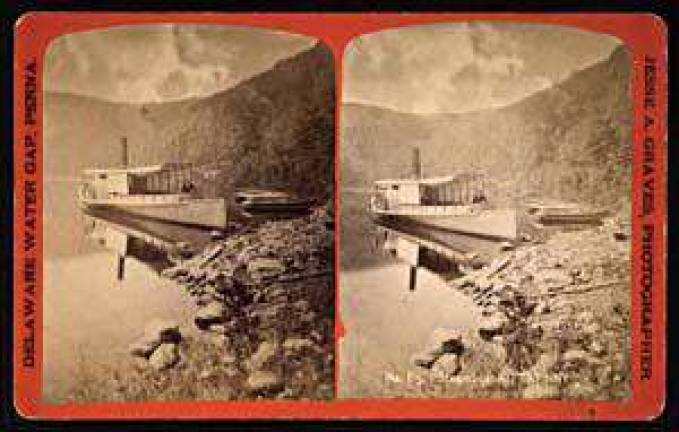The wreck of the Kittatinny

DINGMANS FERRY-The Delaware does not have the Mississippi’s colorful history of majestic steamboats. Today, canoes and rafts are chief users of park waters. Much of 19th century commerce on the river was the lumber and the huge timber rafts that were poled downstream to market, but there was a steamboat era as well. The stretch of river between Dingmans Ferry and Milford presents a treacherous route for commercial navigation. In the 19th century it stood in the way of the day’s newest and most luxurious means of travel which sought to link wealthy folks in the north to one of the hottest recreation spots on the East Coast, a place that offered fresh air, beautiful scenery, and relaxation. A short article appearing in The New York Times on April 28, 1880 (128 years ago) reported that on the previous day, “The steam-boat Kittatinny, owned by the Broadhead (sic) brothers, of the Delaware Water Gap made its first trip of this season to-day, reaching Port Jervis without mishap.” The journey was a historic one. It marked the first successful trip of a steamboat on the Delaware River north of Easton. The boat was owned by the Brodhead Brothers and was used to transport guests from as far north as Port Jervis, N.Y., downstream to the popular Kittatinny resort. The resort was the first in the Delaware Water Gap, having opened its doors in 1832. By the close of the Civil War, it accommodated up to 250 guests and contributed to the area becoming a well-known recreational destination that even presidents like Theodore Roosevelt couldn’t resist. The April 27 voyage of the steamboat Kittatinny was of particular significance because at least twice before, attempts to navigate the upper Delaware proved dangerous and even fatal. The steamboat “Alfred Thomas” was the first ship to undertake this task. It was built to shuttle passengers between Belvedere, N.J. and Port Jervis, a span of 60 miles. On its first voyage on March 6, 1860, the steamboat stopped to let about 60 passengers off at Northampton Street Bridge while on its way to Belvedere from Easton, where it was constructed. With forty passengers on board, the boat continued upriver until it got to a falls, where it pulled along shore to build up steam in order to fight against the current. Upon resuming its trip, the boat was suddenly blown to pieces because of a boiler explosion. A subsequent Times article reported that people were blown as high as fifty feet in the air and many were severely mangled. “The sight along shore was severely heart-rendering [it] was altogether impossible to describe,” the article recounted. Twelve died and many more were injured. It was not until memories of this disaster faded almost two decades later that a similar task was undertaken again, this time by the steamboat Kittatinny. The boat was on a trial run on May 23, 1879 when disaster struck yet again. “The little steamer glided rapidly on down the stream,” a Times article reported. That was the case until the boat reached Burrell’s Rift, which was said to be about two miles north of Dingmans Ferry. The ship was steered too close to the New Jersey side, according to the article, and caused the steamboat to strike a rock, which tore a large hole in its bottom. The Kittatinny was inundated with water. “All on board set to work throwing into the river all wood, coal, and other unnecessary freight, after which they got out into the stream, and with poles and such implements as could be obtained, worked to remove the vessel from the rock,” the article continued. Upon blowing its loud whistle, help from the surrounding area arrived to aid in the effort to free the ship, which lasted over three hours. The ship remained there until it was repaired and the water rose enough for it to be taken back to port. The article concluded by stating that until obstructions were cleared between Dingmans Ferry and Milford, another attempt would not be made. Less than one year later, steamboat Kittatinny made its first successful voyage, and thus began a long history of luxurious transportation in the Delaware Water Gap and romantic moonlight cruises on the river, but reservations are no longer being accepted.